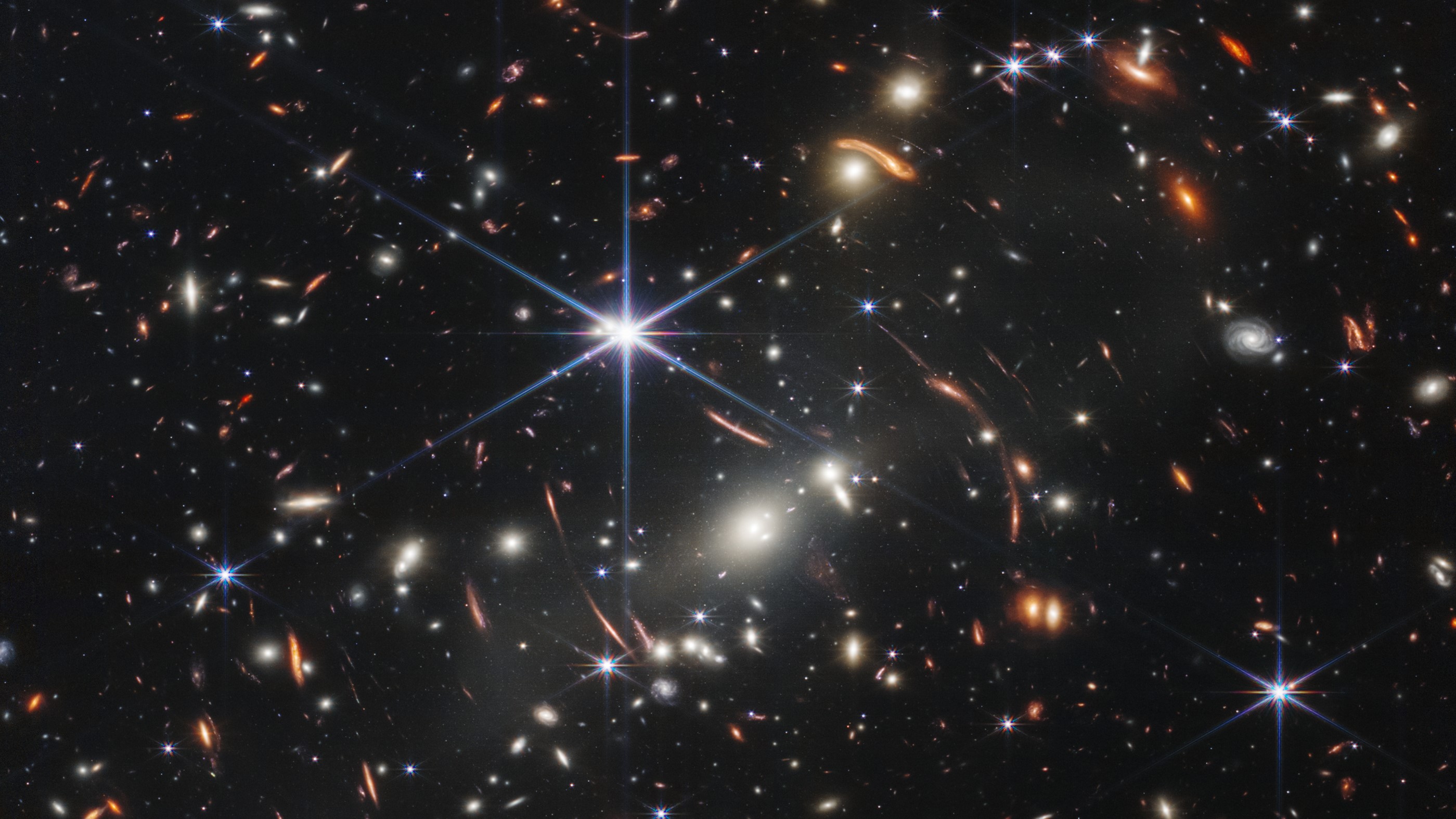Biden unveils James Webb Space Telescope's ultradeep view of the universe
A new era of seeing deeper into the universe than ever before has begun.
President Joe Biden, Vice President Kamala Harris and NASA Administrator Bill Nelson unveiled the first science-quality image captured by the $10 billion James Webb Space Telescope on Monday (July 11) at the White House. The image is the deepest infrared view of the universe to date, according to a NASA statement, and was created using just 12.5 hours of observing time on one of the telescope's four instruments.
"Today represents an exciting new chapter in the exploration of our universe," Harris said. "From the beginning of history, humans have looked up to the night sky with wonder and thanks to dedicated people who have been working for decades in engineering and on scientific marvels, we can look to the sky with new understanding."
Gallery: James Webb Space Telescope's 1st photos
Live updates: NASA's James Webb Space Telescope mission
Biden hailed the image for its representation of the nation and the power of science. "This telescope embodies how America leads the world, not by the example of our power, but the power of our example," he said.
The White House reveal is a prelude to a NASA event releasing the rest of the first JWST images on Tuesday (July 11) beginning at 10:30 a.m. EDT (1430 GMT), which you can watch here at Space.com courtesy of the agency.
NASA has already promised some of the celestial objects that space fans can look forward to seeing in these images. On Friday (July 8), the agency announced that tomorrow's event would offer views of the Carina and Southern Ring nebulas, as well as Stephan's Quintet of closely packed galaxies. Also on the agenda is observations of an exoplanet called WASP-96 b, although JWST won't be offering an image of the distant world. Instead, scientists will share a spectrum of the planet, which splits light by wavelength, offering insight into the chemical composition.
Get the Space.com Newsletter
Breaking space news, the latest updates on rocket launches, skywatching events and more!

Meanwhile, today's image shows SMACS 0723. That uninspiring designation marks a galaxy so massive that it bends and magnifies light coming from objects in space behind it as seen by the observatory. The combination of JWST's high-powered observing capabilities and the effect of gravitational lensing means that this image is the deepest infrared view of the universe that humans have seen to date.
"If you held a grain of sand on the tip of your finger at arm's length, that is the part of the universe that you're seeing, just one little speck of the universe," Nelson said at the White House.
Today's release marks the climax of nearly seven months of carefully orchestrated space operations since JWST launched on Dec. 25, 2021. The telescope spent its first month after blast off trekking out to its station in orbit around what's called Earth-sun Lagrange point 2, nearly 1 million miles (1.5 million kilometers) away from Earth on the side opposite the sun.
Simultaneously, the spacecraft deployed from a launch-friendly compact configuration, including unfurling the massive kite-shaped sunshield that allows the observatory to study the cosmos in infrared light. The telescope also unfolded its golden mirror and spent weeks finetuning the positions of its 18 hexagonal segments.
Finally, the team behind JWST calibrated each of the four key science instruments, ensuring that each of the spacecraft's 17 observing modes worked properly. That work continued to within hours of Biden's remarks, with the final instrument's last mode approved for science earlier on Monday.
The images released today and tomorrow mark the beginning of JWST's career as a full-fledged space observatory.
Next up, the telescope has a special slate of other early science to complete by its first anniversary in space. These observations cover everything from Jupiter to galaxy formation in the early universe and are designed to help scientists learn how to use JWST's data most effectively.
Then, the telescope will dig into what scientists call its Cycle 1 observations, which will continue until next summer.
Although the observatory was designed to operate for five years, NASA officials have said they expect to reach 20 years with the telescope thanks to a particularly accurate launch that saved fuel. JWST's venerable predecessor, the Hubble Space Telescope, has notched 32 years of work, although astronauts were able to upgrade that instrument through 2009.
NASA officials noted that even though it is based on just 12.5 hours of observations, the new image is deeper than Hubble's most ambitious deep fields, which were built on weeks of data.
But for Nelson, the image is even more revolutionary when put in a longer historical context.
"100 years ago, we thought there was only one galaxy," he said. "Now the number is unlimited."
Email Meghan Bartels at mbartels@space.com or follow her on Twitter @meghanbartels. Follow us on Twitter @Spacedotcom and on Facebook.
Join our Space Forums to keep talking space on the latest missions, night sky and more! And if you have a news tip, correction or comment, let us know at: community@space.com.

Meghan is a senior writer at Space.com and has more than five years' experience as a science journalist based in New York City. She joined Space.com in July 2018, with previous writing published in outlets including Newsweek and Audubon. Meghan earned an MA in science journalism from New York University and a BA in classics from Georgetown University, and in her free time she enjoys reading and visiting museums. Follow her on Twitter at @meghanbartels.









